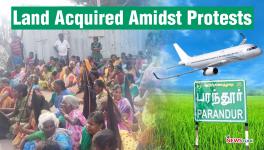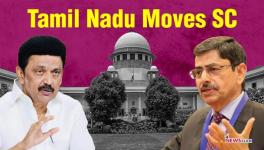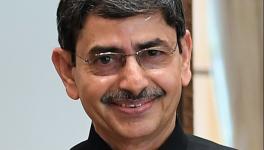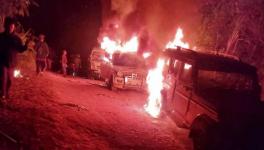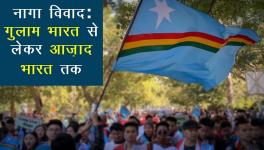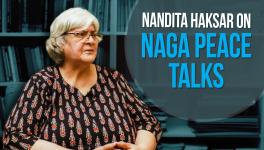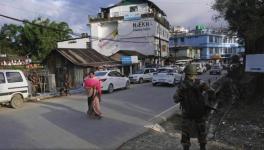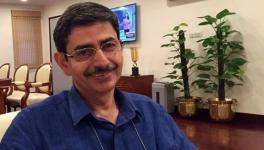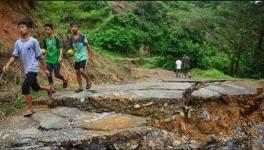Why the Indo-Naga Peace Process Is Dead
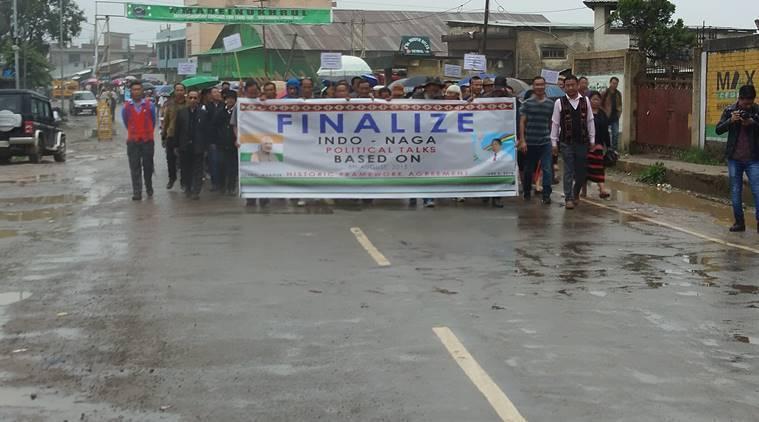
Representational image. | Image Courtesy: Indian Express
The failure of the Indo-Naga peace process is very much like the story Gabriel Garcia Marquez tells in his book Chronicle of a Death Foretold.
In the novel, the setting is a small village in Colombia; here the setting is in a corner of India. Like in the Death Foretold, everyone knows that the murder is going to be committed; everyone has played a role in the crime. There is no one who is not complicit.
POLITICAL SIGNIFICANCE OF THE CONFLICT
The Naga national movement was born at the height of the Cold War and the fear of the West and the Indian Government was that it could become a Communist stronghold. China hoped to keep the Nagas within its sphere of influence.
Pakistan, China, the USA and Britain all played a role to keep alive the idea that the North East region was not a part of India. There was even a plan to make it a kind of Hongkong.
David R. Syiemlieh in his book, On the Edge of Empire: Four British Plans for North East India, 1941–1947, has documented how the idea of keeping the North East region excluded was part of a secret British plan during the closing years of their rule, discussed at the highest levels of the colonial administration for setting up a Crown Colony comprising the hill areas of North East India and the tribal areas of Burma.
The strategic and geographical location of the North East, boxed in by four countries viz., China (Tibet), Burma, East Pakistan, and Bhutan, with only a 22 km wide chicken-neck corridor of Siliguri linking it with mainland India, fitted well into the scheme of the colonial rulers to turn the region into their ‘Crown Colony’ under the ‘Coupland Plan’.
The leaders of the Naga national movement, including Z A Phizo rejected this proposal in the hope of negotiating with the Indians after they got their independence.
However, the geo-political significance of the Naga homelands has ensured the continued international interest in the Naga movement for sovereignty. And, China has continued to play a significant political role in sustaining the movement.
It is not in the interest of any of these countries that the Indo-Naga conflict is resolved.
THE INDO-NAGA RELATIONS
It is important to remember that there has been a section of Naga nationalists who have always thought it wiser to negotiate with the Indians. These Naga nationalists also wanted all the Naga-inhabited areas under one administration within India, even if the unification with the Naga-inhabited areas in Myanmar was not immediately possible.
These Naga nationalist leaders include T Sakherie, an Angami, and Runsung Suisa, a Tangkhul, both members of Phizo’s Naga National Council. Suisa stood for elections on Congress ticket and won from the Outer Manipur constituency in the 1957 general elections. It was Suisa who had suggested that the Nagas become a part of the Indian Union much on the same terms as the Princely States had acceded, by which he meant the Nagas have autonomy on all matters except defence, foreign affairs and communication.
Also watch: Naga Debate: From Colonial Times to Nowf
The Indian leadership failed to take the Nagas seriously, dismissing them as primitive tribals and in response to their demands, the Indians sent in their security forces. And thus, began a history of brutal suppression of Naga people and their growing alienation from the Indian state.
FRAMEWORK FOR THE PEACE PROCESS
However, the geo-political significance of the Naga homelands compelled the Indians to negotiate with the Naga insurgents.
Three people can be credited for bringing the Indian Government and the Nagas to the negotiating table. It was Deepak Dewan, the editor of a Delhi-based weekly called North East Sun, who wanted an exclusive interview with Th Muivah, underground at that time. And he finally managed to get the interview with the help of Grinder Muivah, Th Muivah’s brother’s son. The interview was published and then Dewan took Grinder to Rajesh Pilot and the wheels of the peace process were set in motion.
In July 1995, P V Narasimha Rao, the then Indian Prime Minister, met the two National Socialist Council of Nagaland (NSCN) leaders, Isak Chishi Swu and Th Muivah in Paris. Successive prime ministers, too, personally met the Naga leaders.
And finally in 1997, the NSCN leaders and the Government of India resolved to sit across and discuss the possibility of peace. The Indian Parliament was informed and the process began.
The peace process was based on three basic conditions:
1. The peace talks will be unconditional. By this, it meant there would not be talk of having an arrangement within the Constitution of India.
2. The talks would be held at the highest level, in other words, the negotiators would be a person directly responsible to the Indian Prime Minister and on the Naga side, Th Muivah holds the position of Prime Minister in the Naga underground government.
3. The talks would be outside India.
4. There would be an elaborate mechanism for maintaining a ceasefire; and with some conditions the Naga Army were allowed to carry their arms and have their camps, which were to be designated.
This meant that the Naga Army officers were allowed to carry their arms as long as they were not seen; but they could have their arms within the Designated Camps.
A senior former Indian Army officer was usually in charge of the ceasefire monitoring along with senior officers of the Naga Army.
Throughout the peace talks, the Nagas ran their parallel government and the Naga Army continued to train new recruits.
However, one can see this framework is unique and seemed to offer a level playing field for negotiations.
MANIPUR FACTOR
The first obstacle to the peace process was the demand of the NSCN that the ceasefire should not be confined to the state of Nagaland since the organisation had operations all over the North East. They wanted the ceasefire to be without territorial limits.
The Manipur Government objected because they said this demand was an indirect way of claiming that the hill areas of Manipur were a part of the Naga homelands.
From the point of view of the Meiteis, the erstwhile Princely state of Manipur had always included the hill areas. There were many traditions which linked the Hills with the Valley from ancient times.
The Nagas of Manipur have, from the time of Indian Independence, asked for a separation from the Valley of Manipur which is dominated by the Vaishnavite Hindus and some Meitei Muslims; whereas the tribal people of the Hills mostly follow Christianity. It was these conversions that caused the chasm in the Manipur state.
There are some Naga intellectuals who have also supported the idea of the unity of the Hills and Valley. Others have pointed out the Hill people have not been treated equally and remain backward and without basic amenities.
The Nagas and their supporters argued that India had created three states in 2000, Jharkhand by bifurcating Bihar; Chhattisgarh by bifurcating Madhya Pradesh and Uttarakhand from bifurcation of Uttar Pradesh. Later, the state of Telengana was carved out from Andhra Pradesh, so why could the Naga-inhabited areas not be consolidated under one state? The Centre had the power to do so.
Yes, indeed there was nothing in the Indian Constitution that prevented the Government of India from conceding the Naga demand. However, the dismembering of Manipur would lead to bloody clashes between the armed groups; and there are more than 20 groups representing all the communities living within the state with international links.
NAGALAND FACTOR
The Nagaland state Assembly has passed six resolutions demanding the merger of Nagaland state with the contiguous Naga inhabited areas: the first one was on December 12, 1964, and the last was on September 18, 2018.
The Nagas of Manipur had passed similar resolutions. For instance, Suisa was one of five hill leaders named by the president of the Manipur State Darbar to participate in the Constitution-Making Committee in 1946. However, Suisa and the other hill leaders did not attend the first session of the Committee. On August 13, 1947, he chaired a meeting of hill leaders, at which the assembled demanded that the hill peoples should have the right to secede from Manipur after a five-year period.
But the Nagaland government under S Jamir played a significant role in dividing Nagas of Nagaland and Nagas of Manipur into two camps. At one time, the Congress party had passed a resolution supporting the integration of Naga-inhabited areas; but under Jamir, the Congress party played a major role in the divide and rule game.
ROLE OF INTELLIGENCE AGENCIES
The Indian and western intelligence agencies have played a big role in manipulating the Baptist church in undermining the possibility of a socialist vision of Naga society. It has been the church which has run the most vociferous anti-communist campaigns in the past and continues to attack the NSCN for trying to bring socialism into the Naga society.
The intelligence agencies have played a big role in the Indo-Naga conflict as well as in the peace process. These intelligence agencies have played the divide and rule game with deadly consequences. Today, the Naga national movement is divided into many organisations and the NSCN is now divided into at least five separate groups.
These divisions have come about in part by the growth of tribalism, and the divide between the Nagas of Manipur and the Nagas of Nagaland.
The Naga nationalists see the creation of the state of Nagaland as a device to create a schism between the Nagas. And today, the Nagas of Manipur staying in Nagaland state are denied the basic rights because they are not recognised as tribes within Nagaland.
The intelligence agencies were also responsible for the arrest of Th Muivah in 2000 and also the arrest of Grinder Muivah. The senior Muivah was arrested in Bangkok on his way from Pakistan for the peace talks. Grinder was arrested at Kolkata on his way back from Bangkok after meeting his Uncle in jail.
Grinder was framed in a case of conspiracy to hijack a plane from Mizoram to rescue his Uncle. It was obviously a trumped up case and was withdrawn later.
Also watch: Shadow of Kashmir Over Nagaland Peace Talks?
The intelligence agencies have recruited many Nagas who have also played a role in sabotaging the peace process. And in part, the NSCN leadership is afraid that any promises made will be rescinded.
NEGOTIATING A PEACE DEAL
The NSCN leaders who are negotiating have no experience with negotiations. Their earliest advisor was a lawyer called Michael van Walt van Praag and he helped the NSCN become a member of the Unrepresented Nations and Peoples Organisation. Michael has been the legal advisor to the Dalai Lama in the negotiations with the Chinese. He also had an NGO, Khreddha.
Michael van Walt is a mediator and has facilitated peace processes and advised parties engaged in such processes in Africa, Asia, the South Pacific and the Caucasus.
The NSCN also had another foreign lawyer to advise them, Anthony Regan, who is a constitutional lawyer specialising in constitutional development as part of conflict resolution. He has lived and worked in Papua New Guinea for 15 years and in Uganda for over three years.
With the help of these lawyers, the NSCN travelled to various parts including Papua New Guinea and even South Africa. But, without the knowledge of the Indian Constitution they could not possibly come up with a viable document on the basis of which they could negotiate. And their legal advisors did not know the workings of the Indian Constitution, so some of the suggestions they had were already in the Indian Constitution.
The NSCN had just one demand: the unification of the Naga inhabited areas under one administration – at least within India. A similar process was on among the Nagas of Myanmar with one faction wanting to be a part of the pro-democracy movement while Khaplang wanted to continue to fight for independence.
NON-PLAN PUT FORWARD
The peace process did not progress from 1997 to 2010. The only issue that was discussed was the issue of extension of ceasefire to Manipur, the presence or absence of designated camps in Manipur and various cases of ceasefire violations on both sides.
In 2010, the interlocutor of long years, Padmanabhaiah, was replaced with another interlocutor, R S Pandey, who had been Chief Secretary in Nagaland. It was he who put forward a Non Plan which had some concrete proposals.
The Non Plan suggested the possibility of a Pan Naga body which could unite all the Nagas in different states without changing the borders of the existing states.
What exactly this would mean was not clear. So, in 2011, the NSCN invited a group of lawyers from various parts of the world (with the approval of the Indian Government) and there were two-day deliberations on how the proposals in the Non Plan could be concretised. The lawyers included Prof Yash Ghai who had been responsible for the new Kenyan Constitution. I was there in the meetings.
The NSCN also had a small group of its senior members study the Indian Constitution to try and put together a document on the basis of which concrete negotiations could take place.
However, the proposals put together after long and hard deliberations and submitted to the NSCN never saw the light of day.
FRAMEWORK AGREEMENT
Ravindra Narayana Ravi, a police officer of 1976 batch, was special director of the Intelligence Bureau in 2012. He was the Chairman of the Joint Intelligence Committee from 2014. He was appointed as Deputy National Security Advisor of India on October 5, 2018, and Governor of Nagaland state in July 2019.
It was Ravi who is credited with brokering the Framework Agreement on August 3, 2015. There is a controversy over the exact wordings of the Agreement. The NSCN version of the “original agreement” is given below:
FRAMEWORK AGREEMENT BETWEEN THE GOVERNMENT OF INDIA (GOI) AND THE NATIONAL SOCIALIST COUNCIL OF NAGALAND (NSCN)
1. The political conflict is about six decades old. Attempts have been made for its comprehensive resolution through discussions between the Government of India and the representatives of the Naga people from time to time. A fresh attempt in this regard was initiated through a political dialogue between the GOI and the NSCN in 1997.
2. The GOI and the NSCN dialogue led to a better mutual understanding. While the GOI in expression of the understanding recognised the unique history and position of the Nagas, the NSCN understood and appreciated the intricacies of the Indian system.
3. With such an understanding and with due appreciation of the imperative of the contemporary realities and regard for future vision, both sides have agreed to reach an agreement that will end the violent confrontation once and for all, and will usher in comprehensive progress consonant with the genius of the Naga people.
4. Both sides have understood each others respective positions and are cognisant of the universal principle that in a democracy, sovereignty lies with the people. Accordingly, the Government of India and NSCN, respecting people’s wishes for sharing the sovereign power as defined in the competencies, reached an agreement on August 3, 2015 as an honourable solution. It was successfully concluded and they are confident that it will provide for an enduring inclusive new relationship of peaceful co-existence of the two entities.
4. The two sides agreed that within this framework of agreement, details and execution plan will be worked out and implemented shortly.
The signatories are: Isac Swu, chairman NSCN; Th Muivah, General Secretary NSCN; R N Ravi. Representative of Government of India.
Soon after the signing of this Framework Agrement, Isac Swu passed away.
FUTURE VISION FOR PROGRESS AND PROSPERITY
Herein lies the core of the problem – Phizo’s vision of a nation which had no classes and was based on race and tradition has little meaning in the changed conditions of the 21st century. The Naga society today is as deeply divided along class lines as any other. The large scale immigration of uneducated Naga youth to different parts of the country and abroad testify to the growing class divide which is converting some Nagas into migrant workers and others into prosperous middle classes.
And the Naga traditions are deeply patriarchal; women have been denied representation in public bodies on the grounds that it was against tradition.
The NSCN vision of a future Naga society is a nation based on religion, and their slogan Nagaland for Christ would make their nation a theocracy. There has been little tolerance for outsiders, whether it is migrants (at least in one case a migrant was lynched to death) or for religious minorities like the Catholics, who have been not allowed to bury their dead.
Also read: The Treacherous Path of Nationhood
The Naga intelligentsia have been critical of the NSCN on many counts, but they themselves have not produced an alternative vision for a more inclusive Naga society. They have also not produced a critique of colonial scholarship which they uncritically incorporate in their studies of their society.
The fundamentalist nature of their religion makes them allies with the Americans and the West, and so the word socialist in the NSCN name is meaningless.
Human rights movement has also served to delegitimise any political debates and have confined the Naga national question to merely a question of human rights. Human rights and other civil society groups have become over dependent on foreign funds without once questioning the politics of that funding and the agenda of the agencies.
The political parties, including those supported by the Naga nationalists have only worked for their narrow political interests and have not put forward any vision for the Naga people. There is a bankruptcy of both political imagination and ethics in their dealings with the people.
Thus, the Naga national movement has become an identity movement without any vision for a future that envisages a programme for the development of the Naga people, who have sacrificed and suffered so much in the hope of living in a society which offers them freedom from oppression and self respect.
As for the Indians, they have shown little interest in the entire Indo-Naga peace process and have not questioned the lack of transparency. The media has not reported the real issues and often enough written stories based on handouts by intelligence agencies on the mistaken belief that the agencies represent Indian interests. In the end, the failure of the Indo-Naga talks will hurt Indian interests as much as it does the Naga people.
The vast majority of the Naga people live without regular water supply and electricity; many do not have money for education for their children; majority of Nagas do not have access to health care or to housing. And after the pandemic, many are staring at only a bleak future for themselves and their children. It is the future of these people that should have been at the heart of the Indo-Naga peace talks, but it never was.
The author is a human rights lawyer, teacher, campaigner and writer. The views are personal.
Get the latest reports & analysis with people's perspective on Protests, movements & deep analytical videos, discussions of the current affairs in your Telegram app. Subscribe to NewsClick's Telegram channel & get Real-Time updates on stories, as they get published on our website.









